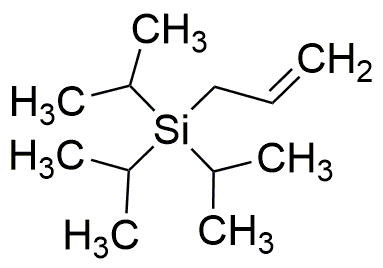Allyltriisopropylsilane is widely utilized in research focused on:
- Organic Synthesis: This compound serves as a versatile reagent in organic chemistry, facilitating the formation of carbon-carbon bonds. Its unique structure allows for selective reactions, making it ideal for synthesizing complex organic molecules.
- Silane Coupling Agents: In the field of materials science, it acts as a silane coupling agent, enhancing the adhesion between organic polymers and inorganic surfaces. This application is particularly beneficial in the production of composite materials.
- Protective Groups in Synthesis: It is used as a protective group for alcohols and amines during multi-step syntheses. This ensures that sensitive functional groups remain unreacted, improving yield and purity in the final product.
- Pharmaceutical Development: In medicinal chemistry, it aids in the development of new drugs by serving as a building block for various pharmaceutical compounds, optimizing their efficacy and stability.
- Polymer Chemistry: The compound is employed in the formulation of specialty polymers, where it contributes to improved thermal stability and mechanical properties, making it valuable in industries such as automotive and aerospace.
General Information
Properties
Safety and Regulations
Applications
Allyltriisopropylsilane is widely utilized in research focused on:
- Organic Synthesis: This compound serves as a versatile reagent in organic chemistry, facilitating the formation of carbon-carbon bonds. Its unique structure allows for selective reactions, making it ideal for synthesizing complex organic molecules.
- Silane Coupling Agents: In the field of materials science, it acts as a silane coupling agent, enhancing the adhesion between organic polymers and inorganic surfaces. This application is particularly beneficial in the production of composite materials.
- Protective Groups in Synthesis: It is used as a protective group for alcohols and amines during multi-step syntheses. This ensures that sensitive functional groups remain unreacted, improving yield and purity in the final product.
- Pharmaceutical Development: In medicinal chemistry, it aids in the development of new drugs by serving as a building block for various pharmaceutical compounds, optimizing their efficacy and stability.
- Polymer Chemistry: The compound is employed in the formulation of specialty polymers, where it contributes to improved thermal stability and mechanical properties, making it valuable in industries such as automotive and aerospace.
Documents
Safety Data Sheets (SDS)
The SDS provides comprehensive safety information on handling, storage, and disposal of the product.
Product Specification (PS)
The PS provides a comprehensive breakdown of the product’s properties, including chemical composition, physical state, purity, and storage requirements. It also details acceptable quality ranges and the product's intended applications.
Certificates of Analysis (COA)
Search for Certificates of Analysis (COA) by entering the products Lot Number. Lot and Batch Numbers can be found on a product’s label following the words ‘Lot’ or ‘Batch’.
Numéro de catalogue
Numéro de lot/série
Certificates Of Origin (COO)
This COO confirms the country where the product was manufactured, and also details the materials and components used in it and whether it is derived from natural, synthetic, or other specific sources. This certificate may be required for customs, trade, and regulatory compliance.
Numéro de catalogue
Numéro de lot/série
Safety Data Sheets (SDS)
The SDS provides comprehensive safety information on handling, storage, and disposal of the product.
DownloadProduct Specification (PS)
The PS provides a comprehensive breakdown of the product’s properties, including chemical composition, physical state, purity, and storage requirements. It also details acceptable quality ranges and the product's intended applications.
DownloadCertificates of Analysis (COA)
Search for Certificates of Analysis (COA) by entering the products Lot Number. Lot and Batch Numbers can be found on a product’s label following the words ‘Lot’ or ‘Batch’.
Numéro de catalogue
Numéro de lot/série
Certificates Of Origin (COO)
This COO confirms the country where the product was manufactured, and also details the materials and components used in it and whether it is derived from natural, synthetic, or other specific sources. This certificate may be required for customs, trade, and regulatory compliance.


